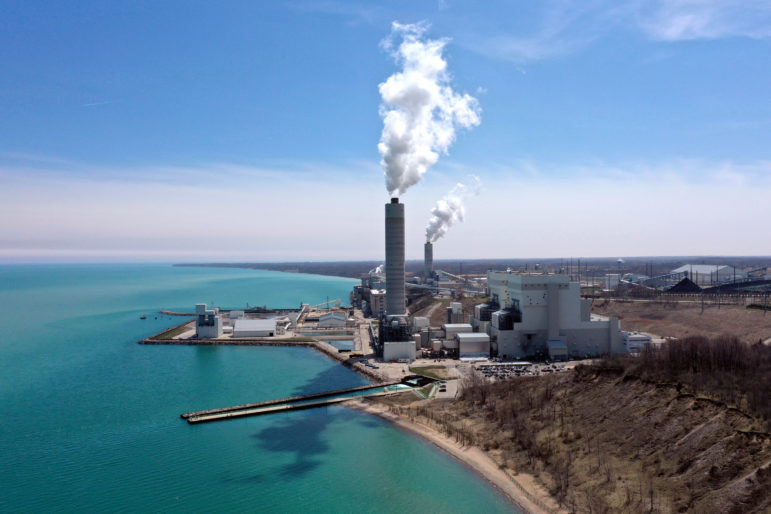We Energies Compounds COVID-19 Danger
Coal burning plants' pollution makes metro area residents less resistant to disease.

The Oak Creek Power Plant and Elm Road Generating Station, seen here on April 25, 2019. Photo by Coburn Dukehart/Wisconsin Watch.
Today and for the foreseeable future all of us face the threat of COVID-19. This disease is particularly hazardous to those with weakened immune systems, and specifically those who struggle with respiratory problems. We who live in southeast Wisconsin are especially vulnerable, because we are breathing the most polluted air in the state. For more than a decade the American Lung Association has given an “F” to the air quality in Milwaukee, Racine and Kenosha counties. Coal is the dirtiest of the fossil fuels, and Wisconsin’s greatest polluter, by far, is our coal-burning energy provider, We Energies.
Many residents of southeast Wisconsin suffer from an unusually high rate of breathing problems. Breathing polluted air puts people at a greater risk of catching the coronavirus and of having a more severe infection. A recent New York Times article tells us “The reasons are twofold: First. air pollution can cause or aggravate respiratory illnesses like asthma or chronic obstructive pulmonary disease. And those illnesses can make you more susceptible to the worst effects of lung infections. Second, exposure to air pollution is known to raise the chance of contracting viruses in the first place, regardless of underlying health conditions”. The article continues with Dr. Meredith McCormack, a spokeswoman for the American Lung Association and associate professor of pulmonary and critical care at Johns Hopkins University summing it up, “All things being equal, a person exposed to air pollution would likely have a worse outcome if he were exposed to coronavirus.”
Residents of Oak Creek well remember the morning, less than two years ago, when they awoke to a layer of coal dust blanketing their homes, driveways, and cars as well as the slide and swings in the playground adjacent to the coal plant. When homes in the neighborhood were tested, 19 of 26 revealed coal dust within. People couldn’t escape breathing it even by being inside. And this infiltration is an ongoing occurrence. Despite closed windows and doors, day and night it sifts in, accumulating inside on windowsills, counters, tables and dressers. This has been the case for decades. And this continues despite We Energies’ recent–and woefully inadequate–containment measures. Day and night, the wind blows dust off the on-site mountains of coal. Simultaneously, dust gets shaken loose from the 120-140 cars that make up one of the many coal trains arriving in Oak Creek. Coal dust pollution is a constant for those living near the tracks on the way to Oak Creek and for those living in Oak Creek proper. According to an internal company study by BNSF Railway, the jostling that occurs can cause each car to lose between 500 and 2000 pounds of coal along the way from Wyoming, where the coal is mined, to Oak Creek. Even with mitigation measures, ThinkProgress estimates that up to 300 pounds of coal dust escape each car.
Need more? A new study by Harvard University’s School of Public Health shows the coronavirus risk to be dramatically heightened for people living in the most heavily polluted areas. The study examined data which dealt with harmful particulate matter in 3,080 counties across the U.S. for the past 17 years. Then it compared pollution levels with the counties’ death rates so far from COVID-19. According to Dr. Francesca Dominici, the lead author, highly polluted counties “will be the ones that will have higher numbers of hospitalizations, higher numbers of deaths, and where many of the resources should be concentrated.” The study concluded that anyone living in a county with high levels of 2.5 microns particulate matter is 15 percent more likely to die if they contract COVID-19 compared to people living in an area with less air pollution.
For all of us at this time, the health of our families, friends and neighbors has never been more important. There is no doubt that coal energy has cost us dearly for decades, causing coal-related health issues, but the advent of coronavirus has made this an all-the-more pressing concern. None of this is news to the executives and board of directors at We Energies and its parent company WEC. The only remedy is clean, renewable and less expensive energy. And the response from We Energies and WEC? The Wisconsin State Journal, in an August 19, 2019 article, reports that Chairman of We Energies Gale Klappa “said earlier this month in an earnings call with analysts that the utility expects to continue running its newest coal plants through mid-century.”
Thirty more years of filthy air is the promise made by We Energies and WEC executives Gale Klappa, Thomas Metcalfe, Kevin Fletcher, and William McKnife. They have their own priorities. Their profits, however short term, are more important than our health. And so they remain determined to burn every last lump of coal until it becomes too costly to do so. Viruses will continue to happen, as they have in the past, but we can be sure that long after COVID-19 has run its course, we will continue to breathe polluted air. Every day coal is burned leads to respiratory problems and weakened immune systems. We Energies is a clear and present danger to southeast Wisconsin. Every day.
Carl Lindner is an Executive Committee member of the Clean Power Coalition of Southeast Wisconsin and Emeritus Professor at UW-Parkside.
More about the Coronavirus Pandemic
- Governors Tony Evers, JB Pritzker, Tim Walz, and Gretchen Whitmer Issue a Joint Statement Concerning Reports that Donald Trump Gave Russian Dictator Putin American COVID-19 Supplies - Gov. Tony Evers - Oct 11th, 2024
- MHD Release: Milwaukee Health Department Launches COVID-19 Wastewater Testing Dashboard - City of Milwaukee Health Department - Jan 23rd, 2024
- Milwaukee County Announces New Policies Related to COVID-19 Pandemic - David Crowley - May 9th, 2023
- DHS Details End of Emergency COVID-19 Response - Wisconsin Department of Health Services - Apr 26th, 2023
- Milwaukee Health Department Announces Upcoming Changes to COVID-19 Services - City of Milwaukee Health Department - Mar 17th, 2023
- Fitzgerald Applauds Passage of COVID-19 Origin Act - U.S. Rep. Scott Fitzgerald - Mar 10th, 2023
- DHS Expands Free COVID-19 Testing Program - Wisconsin Department of Health Services - Feb 10th, 2023
- MKE County: COVID-19 Hospitalizations Rising - Graham Kilmer - Jan 16th, 2023
- Not Enough Getting Bivalent Booster Shots, State Health Officials Warn - Gaby Vinick - Dec 26th, 2022
- Nearly All Wisconsinites Age 6 Months and Older Now Eligible for Updated COVID-19 Vaccine - Wisconsin Department of Health Services - Dec 15th, 2022
Read more about Coronavirus Pandemic here
Op-Ed
-
Wisconsin Candidates Decry Money in Politics, Plan to Raise Tons of It
 Dec 15th, 2025 by Ruth Conniff
Dec 15th, 2025 by Ruth Conniff
-
Trump Left Contraceptives to Rot; Women Pay the Price
 Dec 8th, 2025 by Dr. Shefaali Sharma
Dec 8th, 2025 by Dr. Shefaali Sharma
-
Why the Common Council’s Amended Budget is Good Policy for Milwaukee
 Nov 20th, 2025 by Alds. Marina Dimitrijevic and Russell W. Stamper, II
Nov 20th, 2025 by Alds. Marina Dimitrijevic and Russell W. Stamper, II



















